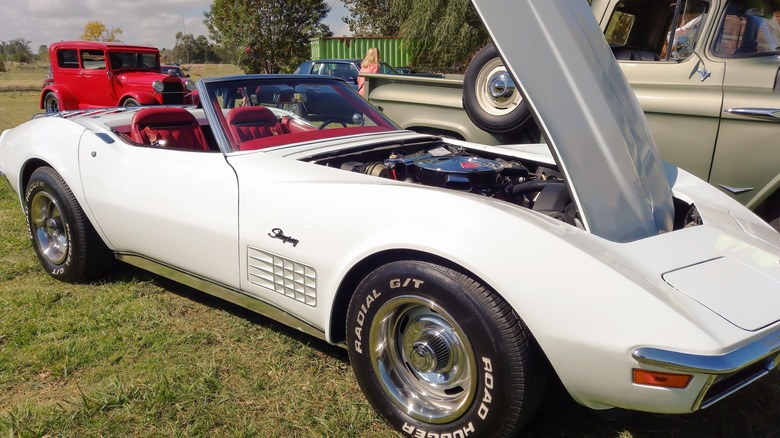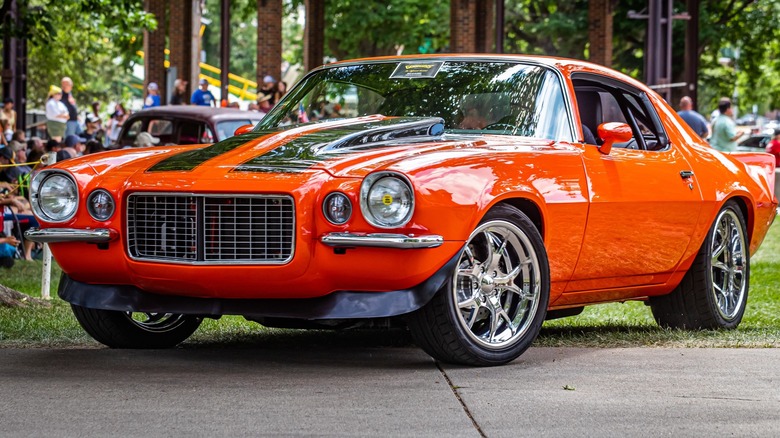Which Cars Have Chevy's LT-1 Engine Under The Hood & How Much HP Does It Have?
The small block Chevy (SBC) V8 has powered several generations of performance cars over the last seven decades. One of the earliest examples to demonstrate the SBC engine's potential is the 350 cubic inch (5.7 liter) LT-1. The LT-1 is considered one of the highest horsepower Chevrolet engines ever built.
Not to be confused with the Gen II LT1, the LT-1 (note the importance of the hyphen) debuted in 1970 as part of the first generation of SBC engines at the height of the muscle car era. Chevrolet produced the LT-1 from 1970 to 1972. However, the 1970 version was the most powerful, as later iterations saw reduced compression ratios and performance.
While the LT-1 was most prominently an option supplied to the Chevrolet C3 Corvette, it was also available for the Camaro Z/28 and special order Yenko customized 1970 Chevy Novas, known as the "Yenko Deuce." Today, any of these cars possessing an original LT-1 are highly sought after.
How much horsepower did the Chevy LT-1 have?
The 1970 Chevrolet LT-1 displaced 350 cubic inches with its 4.00-inch diameter cylinder bore and 3.48 inches of crankshaft stroke. The engine's 11.0:1 compression ratio played a large role in delivering the Corvette version's 370 horsepower and the Camaro Z/28's 360 horsepower.
In addition to the 1970 Corvette's 370 horsepower at 6,000 rpm, the LT-1 also made 380 lb-ft of torque at 4,000 rpm. That was enough power to launch the roughly 3,300 pound 1970 Corvette from zero to 60 mph in under six seconds.
By 1971, the Corvette's LT-1 was detuned to 330 horsepower and 360 lb-ft of torque. The final year of the LT-1, 1972, saw its compression ratio drop to 9.0:1 and net horsepower ratings fell to 255 while torque was reduced to 280 lb-ft.
While power comparisons over these years include discrepancies in reporting methods, zero to 60 mph times don't lie. All three Corvette years weigh around the same 3,300 pounds, but the 1972 LT-1 equipped 'vette posted an 8.5 second zero to 60 mph time compared to the 1970's sub six second mark.
What was special about the 1970 LT-1?
According to MotorTrend, the 1970 LT-1 possessed some "heavy-duty components" that contributed to its increased performance characteristics compared to Chevy's other 350 cubic inch V8s. First, the LT-1 used a special cast-iron engine block with four bolts securing each of the alloy-steel crankshaft's main caps. The forged-aluminum-alloy TRW pistons attached to the crankshaft via 5.7-inch connecting rods, chromium-steel wrist pins, and 0.375-inch bolts.
The LT-1's excellent airflow centered around its solid-lifter camshaft with over 0.45 inches of intake and exhaust valve lift and aluminum cylinder head design. The aluminum heads featured streamlined intake and exhaust ports to reduce restriction, in addition to 2.02-inch diameter intake and 1.60-inch exhaust valves.
Another unique feature of the LT-1 V8 is the high-rise, dual-plane aluminum intake manifold with its divided plenum chamber. Combined with an 800-cfm Holley four-barrel carburetor, the intake system delivered enough fuel/air mixture to feed the free-flowing, high revving LT-1.


